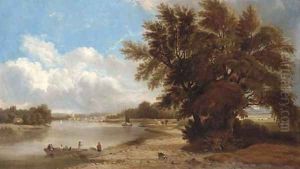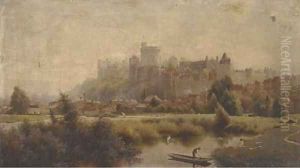Edmund John Neimann Paintings
Edmund John Niemann was a British landscape painter active during the 19th century. Born on April 29, 1813, in Islington, London, he was primarily self-taught, although his father, John Diedrich Niemann, who was a prosperous merchant, might have influenced his early interest in art. Edmund initially embarked on a career in business, working for his father and then for a mercantile firm, but his passion for painting led him to pursue art full-time from the mid-1830s.
Niemann's early works showcased his interest in landscapes, a genre that he would remain devoted to throughout his career. He was particularly drawn to the British countryside, including the Thames, Wales, and the Lake District. His style was influenced by the prevailing Romantic movement, emphasizing dramatic light, atmospheric effects, and a strong sense of mood, qualities that were admired in the works of his contemporaries such as J.M.W. Turner and John Constable. Despite these influences, Niemann developed a distinctive style, characterized by a keen observation of nature and a meticulous approach to detail.
He exhibited his work extensively, showing at prestigious institutions such as the Royal Academy (from 1844), the British Institution, and the Society of British Artists, of which he became a member in 1846. His paintings were well received by critics and the public alike, and he built a successful career, with patrons among the British aristocracy and gentry. Niemann's landscapes not only reflect the beauty of the English countryside but also occasionally incorporate historical or literary themes, adding a narrative element to his scenic compositions.
In the later years of his career, Niemann's style evolved, showing an interest in a more naturalistic representation of light and atmosphere, which aligned with the emerging Impressionist movement. Despite this shift, his work remained rooted in the Romantic tradition. Edmund John Niemann passed away on October 15, 1876, in High Wycombe, Buckinghamshire. Today, his paintings are held in several British institutions, including the Victoria and Albert Museum, and continue to be appreciated for their contribution to 19th-century British landscape painting.

